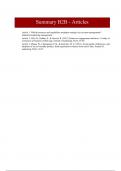Resume
B2B Summary (EBM808B05) - All mandatory articles
- Cours
- Établissement
This document consists of an extensive summary of the three mandatory articles for the B2B course. It has a pleasant layout that makes it easy to read and learn. The mandatory articles: Gill, M., Sridhar, S., & Grewal, R. (2017). Return on engagement initiatives: A study of a business-to-busi...
[Montrer plus]



